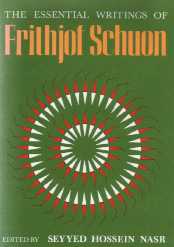|
"The essential writings of Frithjof Schuon" edited by
Seyyed Hossein Nasr, 1986 Note: More books were written after this date. See Bibliography. "In depth and breadth, a paragon of our time. I know of no living thinker who begins to rival him."OOHouston Smith "I have met with no more impressive work in the comparative
study of Oriental and Occidental religion." |
 |
Table of Content
|
Introduction by Seyyed Hossein Nasr Part I : Religion and Revelation The
Nature of Religion Part II: The Study of Religions Comparative
Religion - Methodology Part III: The Nature of Reality Metaphysics
|
Part IV: Art and the Spiritual Significance of Beauty Aesthetics Part V: The Nature
of Man Part VI: The Spiritual Life Elements
and Goal of the Spiritual Path Part VII: Eschatology and the Afterlife Reflections
on Eschatological Problems Part VIII: Criticism of the Modern World Criticism
of Modern Philosophy Part IX: Spiritual Impressions Selected
Poems |
What did Seyyed Hossein Nasr write about Frithjof Schuon...
"The philosophia perennis has come to signify for those devoted to traditional studies an eternal truth at the heart of all traditions corresponding to the Sanatana Dharma of Hinduism and al-hikmah al-khalidah or al-hikmah al-laduniyyah of Islam. It has in fact been given its most profound and genuine meaning, beyond what the post-medieval European philosophers understood by it, in the writings of Frithjof Schuon, which, following closely upon the work initiated by René Guénon and then Ananda Coomaraswamy, may be said to be the most noble and complete expression of the philosophia perennis available in the contemporary world". [Islam and the Perennial Philosophy, p. vii-viii].
"The works of Frithjof Schuon occupy in fact a special place in the vast array of writings which have appeared during this century on metaphysics and religion and which have sought to deal with the perennial philosophy. His authoritative tone, clarity of expression and an "alchemy" which transmutes human language to enable it to present the profoundest truths, make of his works a unique expression of the philosophia perennis which is also the sophia perennis meant to guide the man of today out of the labyrinth of ignorance in which the modern world finds itself. Moreover, his works are channels of a veritable grace (or barakah in Arabic) which reveals a living spirituality behind the thoughts and words expressed. Schuon has stated truths which were never expounded directly in writing before and which now appear in books because, to quote his own words, "one anomaly deserves another".
The perspective of Schuon is that of universal metaphysics, of the religio perennis or religio cordis -- as he himself calls it -- which has been revealed to men through various traditions of celestial origin. Combining an incomparable metaphysical insight with a vast knowledge of various religions in their doctrinal, ethical and artistic aspects, Schuon has delved into the heart of different traditions as well as criticized modern civilization and its various aberrations in the light of the perennials truths of Tradition". [Islam and the Perennial Philosophy, p. viii].
